1959 Italian Grand Prix race report: Walker's cunning bests the reds
Strirling Moss takes advantage of RWR's intelligent strategy to break Tifosi hearts
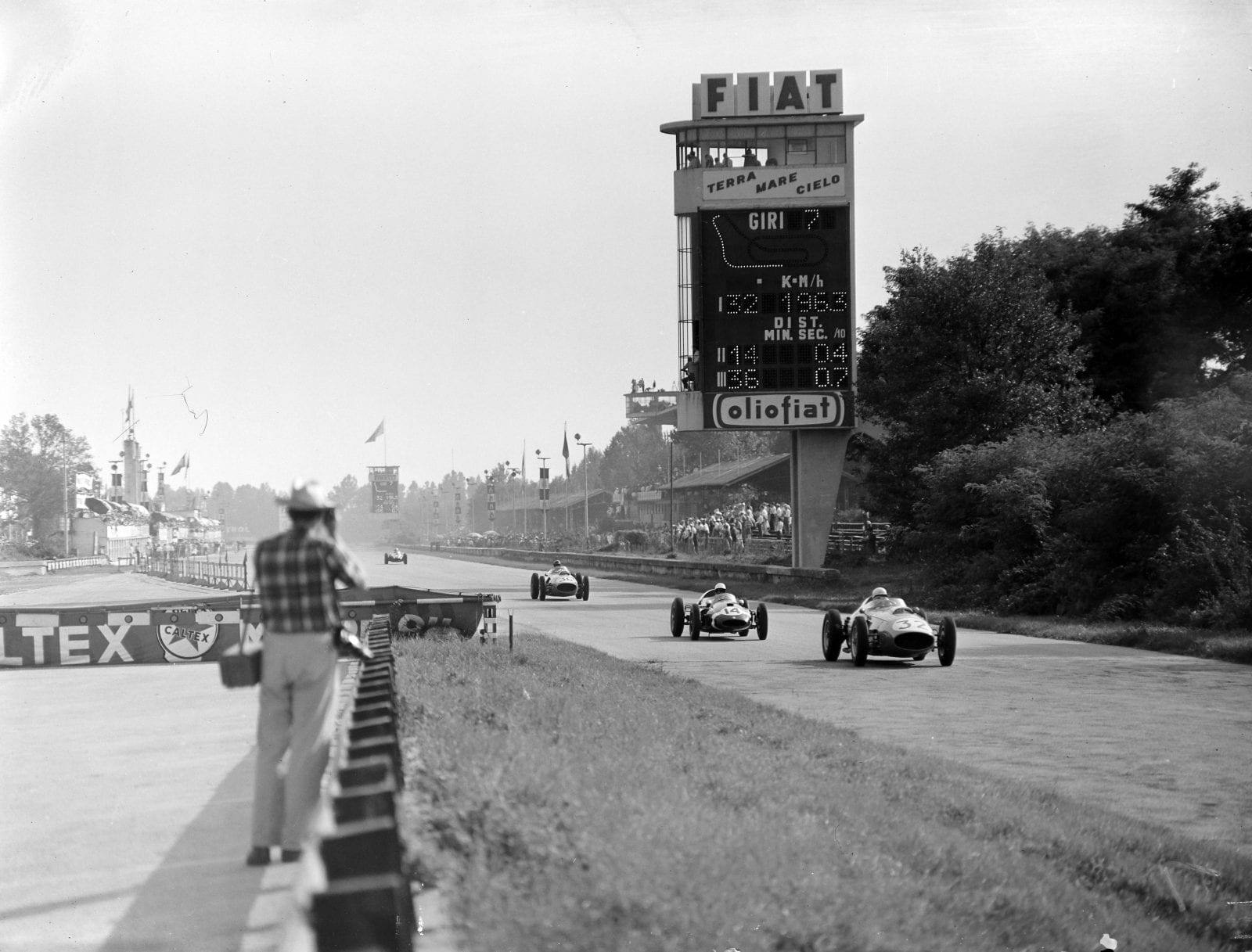
Phil Hill, in a Ferrari 246, leads Stirling Moss driving a Cooper T51 Climax and Dan Gurney also in a Ferrari 246
Motorsport Images
Qualifying
With the Italian Grand Prix winding up the European season of serious motor racing, everyone arrived at Monza prepared for the usual flat-out blind that is synonymous with the very fast track, only the road section being used. Practice began officially on the Friday afternoon, but earlier in the week BRM had been trying out their new mid-engined car and on the Thursday before race-weekend there was much activity with Aston Martin, BRM, Lotus and Cooper all out with one car or more.
Last year the fastest practice lap was set up by Moss in a Vanwall in 1min 40.5sec and the lap record for the race by Phil Hill in a Ferrari in 1min 42.9sec, so that with the improvements made on lap times throughout the season it was reasonable to expect times of under 1min 40sec to be recorded.
As always, the weather was superb when practice began and, everyone being ready to go, the circuit was soon humming with activity. The Scuderia Ferrari were content with the way their engines were going and while the drivers were getting into the swing of things they practised wheel changing, making the drivers stop at the pits in a hurry and then make violent getaways, as they were not too sure about the clutches for standing starts. Some of the starts were most spectacular and some interesting black lines were appearing on the track.
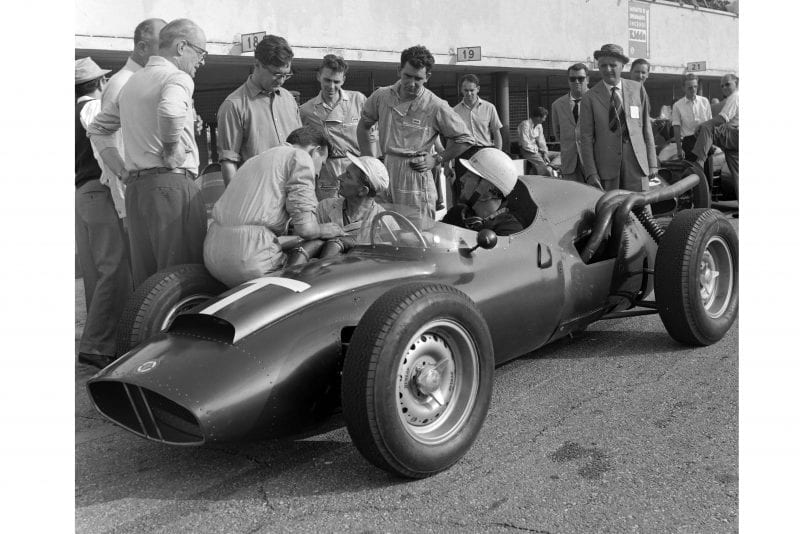
Jo Bonnier in the BRM P25 ‘T’ car in the pits
Mortorsport Images
Most of their lap times were around 1min 42sec or 1.43, which showed little improvement over last year, and it was left to Moss to set the pace, which he did in no mean fashion by recording 1min 39.7sec. Brabham was going fast in between doing carburetter adjustments with a man from the Weber factory, and McLaren was quickly learning his way round the circuit, using his own car and the third works Cooper that Scarlatti was waiting with enthusiasm to try.
Of the BRM team Schell was easily fastest, while Bonnier was doing a lot of running with the new car and the Aston Martins were sounding beautifully crisp and clean but were having difficulty in approaching 1min 45sec, as were the two Lotus drivers. Fairman did a few laps in the Cooper-Maserati and it then died on the far side of the circuit when the fuel pump packed up. Coopers were well pleased with the way Scarlatti was getting on in their third car for he was soon lapping at under 1min 45sec, while Brabham had got down to 1min 40.2sec.
“During this first practice session it was found that tyre wear was pretty alarming”
Gendebien was beginning to go quite quickly in a Ferrari and Graham Hill was out at the same time and by tucking into the Ferrari’s slip-stream he got his time down from a difficult 1min 44sec to 1min 42.9sec, a speed he had no hope of achieving without the “tow” from the Ferrari.
Towards the end of practice Moss went out again and did two flying laps, both under 1min 40sec, and at that he rested content. Brooks was trying hard right up to the end of practice and, by working away at clipping off fractions here and there, he got down to 1min 40.1sec, which gave him second fastest time of the day. During this first practice session it was found that tyre wear was pretty alarming and the Cooper drivers were not too happy with their bolt-on wheels, while Lotus were not going fast enough to worry.
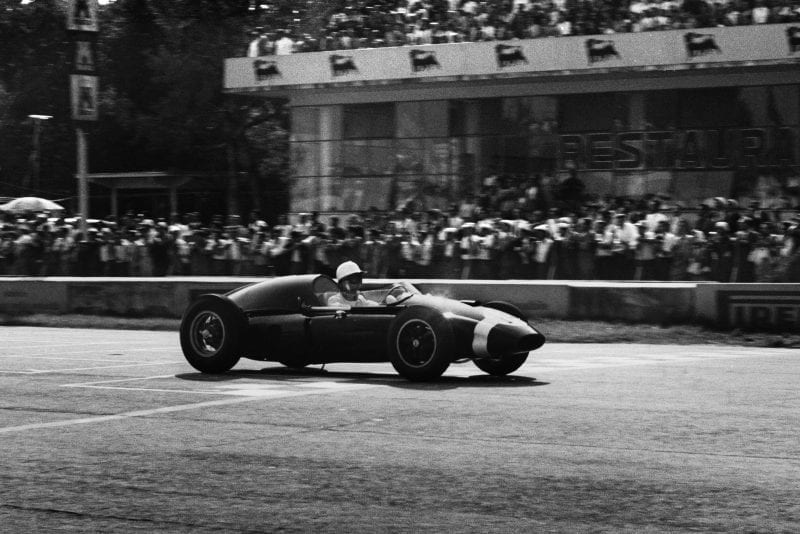
Stirling Moss flying in his Cooper T51-Climax
Motorsport Images
For the second practice period on the Saturday afternoon the Walker Equipe had fitted the Moss car with splined hubs on the rear and knock-off wire wheels, a set of these having been sent over from England. having originally been fitted to Trintignant’s car earlier in the season. Everyone was again out for practice, including the new BRM, which was showing good promise by lapping around 1min 44sec, but with the heat of the mid-afternoon there was not much activity in the way of high-speed motoring.
It was not until within the last hour that things began to hum and the whole Ferrari team were sent out in turn to make a determined attack on the fastest time, which still stood to Moss from the previous day in 1min 39.7sec. First Gurney went out and he really wrung the neck of his car, driving it well to the limit through the corners, and got down to 1min 40.8sec, then Brooks went out to demonstrate his true artistry and got down to 1min 39.8sec, which made Moss reappear, but he did not improve on his Friday’s time.
Allison followed but could not improve on his time of the day before, which was 1min 41.8sec, and then Phil Hill and Gendebien went out together as time was running out. The American improved to 1min 41.2sec and the Belgian made no improvement on his earlier 1min 41.4sec and as Brabham had not bettered his time of Friday it left Moss with FTD, but it was a shaky one, with Brooks very close behind these two being the only drivers to get under 1min 40sec.
Sunday was another perfect day and the morning saw Gran Turismo races, during which an Italian-owned Berkeley 500 beat all the highly-tuned Fiat 500s and a standard Lotus Elite was on the front row of the 1,300cc grid alongside the two fastest Italian Giuliettas. Unfortunately one of the Alfas spun on the opening lap and wrecked itself, the Elite and some other Giuliettas, or there may have been a British victory in that event as well.
Race
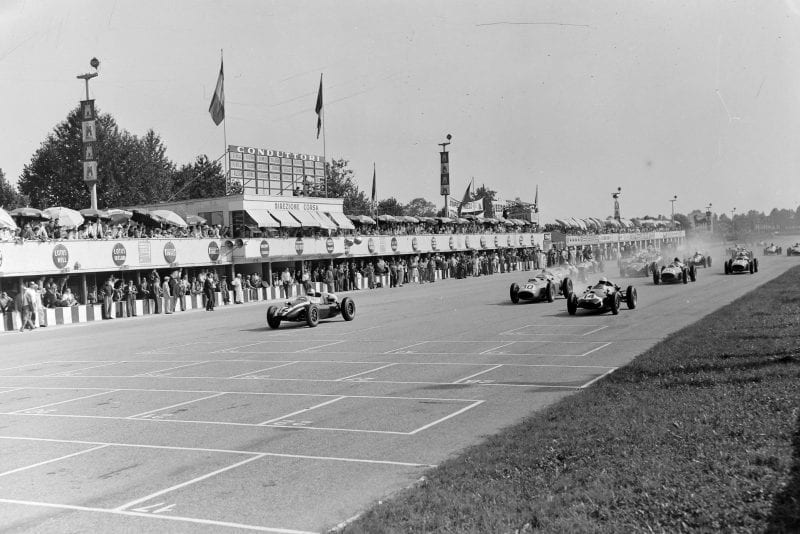
Jack Brabham (Cooper T51 Climax) leads Stirling Moss (Cooper T51 Climax) and Tony Brooks (Ferrari 246) at the start of the Italian GP at Autodromo Nazionale Monza.
Motorsport Images
After a long lunch period and a vast parade of Vespa Scooters from Vespa Clubs from all over Europe, including three stalwarts from Great Britain, the serious business of the Italian Grand Prix got under way. The race should have started at 3pm but it was nearly 20 minutes later before all was set and the cars were lined up in the order shown below in rows of three-two-three this year, whereas previously it had been four-three-four. In view of an anticipated increase in average speed the race length had been extended from 70 laps to 72 laps, so that the total time would be certain to be longer than the two hours minimum laid down in the rules for Championship races.
As the flag fell and the 21 cars surged forward a cloud of smoke came from the back of Brooks’ Ferrari and the Coopers on each side of him shot ahead. The Ferrari was accelerating, but slowly, and cars were passing poor Brooks on all sides, and while the field roared away towards the Curve Grande and Lesmo he came to rest with a broken piston, and Ferrari’s main hope of victory was gone.
He was not alone in trouble on this opening lap, for Fairman had stalled and had to be restarted, and two more Coopers were in trouble, Trintignant with his throttle linkage come adrift and Scarlatti with his gear-lever connection broken, so that they both came into the pits at the end of the lap. Out in front Moss was leading Phil Hill, Brabham and Gurney, followed by Schell, Gendebien, Ireland, Allison, Graham Hill and the rest, with McLaren way back after a poor start.
On lap two Moss let Hill take the lead and was content to sit behind and let the Ferrari set the pace, conserving his tyres by taking the corners gently and catching the Ferrari up again on acceleration.
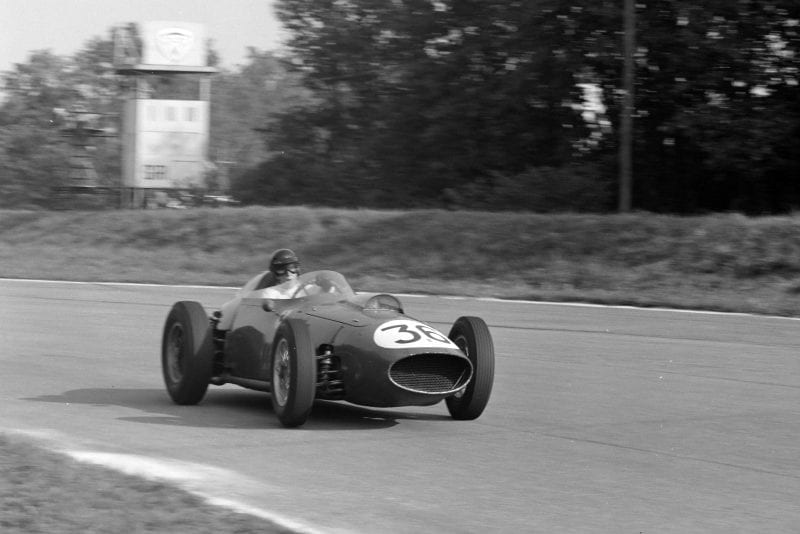
Dan Gurney driving a Ferrari 246.
Motorsport Images
The race was already breaking up into groups, Hill, Moss, Gurney and Brabham in group one, followed by Gendebien, Schell, Ireland and Allison in the next group, then McLaren, Bonnier and Salvadori, and the rest already way behind with Trintignant and Scarlatti trying to make up for their pit stops, while Graham Hill had retired the Lotus with clutch trouble. Fairman was soon in the pits with misfiring and then Ireland joined him, and meanwhile the four leaders were still nose-to-tail, Moss taking the lead on lap four and giving it back on lap five, weighing-up the Ferrari opposition as he did so.
By lap eight Brabham had decided to ease off and save his tyres, as well as to give his gearbox-change speed gears an easier time, and Allison and McLaren were moving up fast, after being hemmed in during the opening laps. Already the tail-enders had been lapped and the average speed was well over 200kph (approximately 124mph), and the Ferrari-Cooper-Ferrari trio were still pressing on.
“Salvadori was going well, in spite of still being bandaged after the TT fire”
From lap 10 to lap 20 the scene at the head of the race was unchanged, the distance covering the three cars being the same all the time, so that it was clear that the two American Ferrari drivers could do nothing about getting rid of Moss and the Walker-Cooper, and by the relaxed way he was driving it seemed that Moss was content to run his race at the speed of Hill’s Ferrari and no more, banking on the fact that they were wearing their tyres out faster than he was.
Allison took fourth place from Brabham and then McLaren caught his team-mate and the two of them were content to cruise round together and await developments, for the race was still young. Salvadori was going well, in spite of still being bandaged after the TT fire, and was closing his Aston Martin on Schell’s BRM, while Fairman and Ireland had both retired after numerous pit stops.
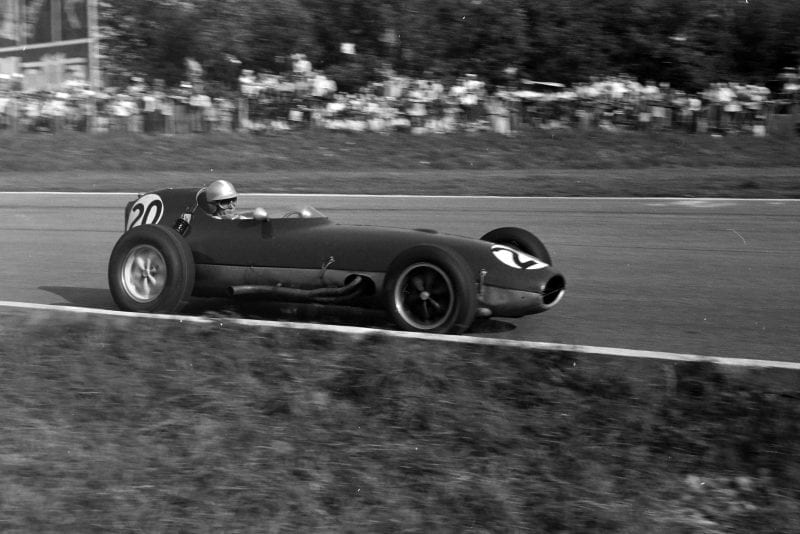
Innes Ireland in his Lotus 16 Climax
Motorsport Images
From lap 20 to lap 30 this cat-and-mouse game between the Cooper and the two Ferraris continued, and one felt that if it was going to develop into a battle of nerves and waiting for the other driver to make a mistake, Moss could not fail to be victorious. On lap 23 McLaren disappeared when a piston collapsed and the rod came through the side, so the order was Hill, Moss, Gurney, Allison, Brabham, Gendebien, Bonnier, Schell and Salvadori, the rest having been lapped.
At the end of lap 33 the Scuderia Ferrari threw away all hope of victory for Phil Hill was called in to change the rear wheels, which was done in a remarkably quick time so that he was off again in fourth place before Brabham appeared. On the next lap Gurney was in and all four wheels were changed, so that Moss was now on his own, followed by Allison, who was not close enough to cause trouble, and when he went into the pits for changing tyres on lap 36 it was all over.
Within the space of three laps the Ferrari team had removed all the pressure from Moss, leaving him way out on his own. Gendebien also had his wheels changed, on lap 38, so that there was now no Ferrari within striking distance, and none of them had any hope of catching up for they had been unable to lap any faster than Moss during the opening stages. Of course, it was assumed that Moss would have to stop to change tyres, but he had been conserving rubber during the opening phase of the race by letting Phil Hill set the pace and could now ease off just that small amount which would make all the difference to the tyre wear. The order was now Moss, Hill, Brabham, Gurney, Allison, on the same lap, followed by Bonnier, Salvadori, Gendebien who was making up for his stop, Schell and Trintignant, the others being way behind.
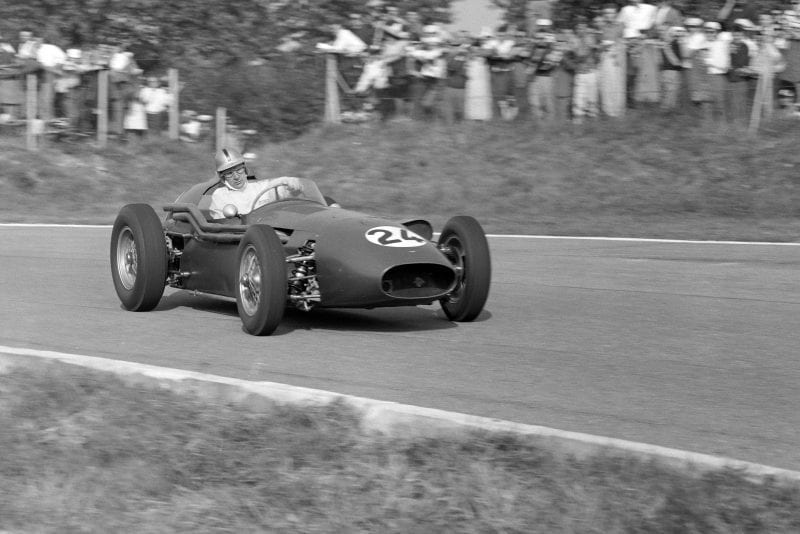
Roy Salvadori at the wheel of his Aston Martin DBR4/250
Motorsport Images
As a race the whole thing now developed into a farce, with the Ferrari team following helplessly in the wake of the Walker-Cooper, unable to do anything about it and realising, as lap after lap went by, that they had boobed by stopping all their cars at the same time. It was obvious that Moss now had no intention of stopping for tyres and had led the entire Ferrari team into a trap, and they had played right into his hands. It was a perfect case of Moss suiting the strategy and his decisions to the pattern of the race as it developed in the opening laps.
“Moss now had no intention of stopping for tyres and had led the entire Ferrari team into a trap”
With Brooks out on lap one his real danger was gone, and once Moss found he could cope with Hill and Gurney without straining himself he could play his own game. The only unknown factor now was the reliability of the Cooper, but as it went on lap after lap as regularly as a clock it was clear that Moss had victory in his grasp, and though Hill occasionally gained a second or two he had no hope of getting to grips with Moss again, while Gurney could not catch Brabham.
On lap 57 Moss lapped Allison, who was in fifth place, but then let him get ahead again and stayed with him for a number of laps as if to relieve the boredom of touring round on his own, but on lap 66 he accelerated away from the Ferrari and carried on on his own. Apart from Gendebien passing Bonnier and Schell and getting back into sixth place, and Salvadori blowing his engine up, the procession lacked any real interest and Moss led the field home at a new record average speed, still with ample tread left on his tyres, whereas Brabham in third place had worn his tyres dangerously thin. It is in such matters as the ability to go fast and conserve his tyres, and to plan the strategy of his actions while he is racing, that makes Moss the great artist that he is.
Monza Minims
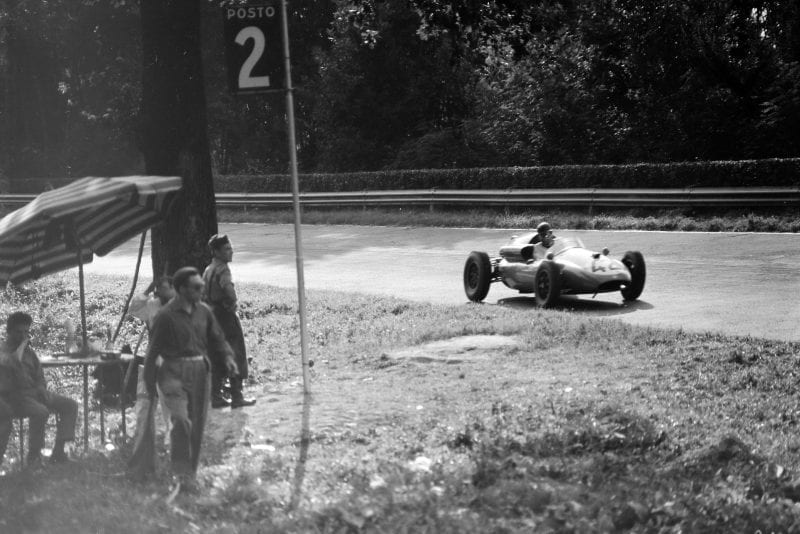
Ian Burgess in a Cooper T51 Maserati
Motorsport Images
- It is getting depressing how often the tyre experts are being proved wrong on the question of wear. It seems there is no rate-of-wear factor between a fast lap and a record lap, nor between rate-of-wear when the tread is brand new and rate-of-wear when it is half-worn, these two quantities being inter-related with a fast lap in 1min 39sec and a lap in 1min 43sec, which is slow by comparison.
- Prize for pit-stop must go to Centro-Sud, who had heard about the possibility of Coopers changing tyres. When Burgess stopped to complain that top gear kept jumping out the mechanics changed his near-side rear wheel and sent him off again, the tyre that came off being nearly new, for lapping at 1 min. 46 sec. or 1 min. 49 sec. the tyres would have lasted a life-time.
- Scarlatti more than justified the loan of the third works Cooper, lapping with Flockhart’s BRM for a long time, and but for his long pit stop would have been better placed.
- One wonders if this was the last Grand Prix for Lotus. Organisers must be getting tired of their dismal performances.
Notes on the Cars at Monza
Technical highlight of the meeting was the appearance of the new BRM during practice, this car not only being a radical break from Bourne tradition but also a sign of the times for the future. Built in a remarkably short time more as an experiment than anything else as yet, it utilised many parts of the existing F1 car. The outstanding changes are the adoption of a mid-engine position instead of a front engine and of independent rear suspension in place of de Dion; in other words the following of Cooper and Porsche principles, with an eye on the 1961 Formula change. The track and wheelbase are identical to the present Formula 1 car as is the front suspension, this being fitted to a new chassis frame built on similar lines to the 1959 cars, using straight small-diameter tubes to form a torsionally rigid space-frame.
The chassis frame ends in a strong cross member at its highest point, to the ends of which are attached the coil-spring/damper units similar to those used on the old cars. These have their lower ends attached to a hub carrier and the lower portion of this carrier is located sideways by a tubular triangular member, whose apex is pivoted on the chassis frame, and fore-and-aft by a radius rod running forward to a point on the chassis beside the engine. Thus each wheel is fully independently sprung on a principle that is a cross between Lotus and Porsche RSK. Drive to the rear wheels is through universally-jointed half-shafts with a sliding spline.
* * *
With the driver sitting at the front, with his feet just behind the front axle centre-line the engine is in front of the rear axle centre line and the gearbox behind it. The engine is the normal four-cylinder 102.8 by 74.9mm 2½-litre unit, but instead of having the twin magnetos mounted on the front of the block they are mounted one on each side of the crankcase and are driven by exposed toothed-rubber belt drives, these being taken from the engine developed for the ill-fated Cooper-BRM of the Moss/Walker team.
The engine is attached directly to a gearbox as used on the front-engined cars, by means of a new bell-housing casting and the single disc brake on the end of the gearbox is retained. Fuel is carried in tanks on each side of the driving seat and the oil tank for the dry-sump lubrication system is mounted in the short nose, behind the radiator, while a slot on top of the radiator cowling gathers air which is ducted to the two double-choke Weber carburetters. By some clever pipe bending the four exhaust pipes are blended into a single tail pipe that does not stick out too far behind the short stumpy tail of the car. Wheels, brakes and steering gear are all as used on the normal F1 cars, and by this means the Bourne technicians have been able to produce a new project, well-made and of interesting potential in a very short space of time. In general appearance the car resembles the F2 single-seater Porsche rather than a Cooper.
In addition to this interesting car there were three of the normal Formula 1 BRM cars for the team of Bonnier, Schell and Flockhart.
The Cooper transporter had not returned to England after the Lisbon race, journeying by easy stages to Monza and rebuilding the cars while the engine from the crashed car and another were flown home for revision. At Monza the remains of Brabham’s crashed car were still in the van and the engine had been built into a spare chassis. This car was fitted with a gearbox having a modified oiling system, whereby a gear type oil pump is driven off the rear of the gearbox.
The other two cars having the earlier type of gearbox oil pump driven from skew gears on the side of the box, both systems using the old drip-feed oil tank as a reservoir for the circulating system. Of the private Coopers at Monza the Maserati-engined one of CT Atkins, driven by Fairman, had this latest Cooper gearbox and oiling system. With Gregory still convalescing after his TT crash, Brabham and McLaren were joined for this race by the Italian driver Scarlatti. The two Walker-Coopers were the same as used in Portugal by Moss and Trintignant, their transporter going direct to Italy, where the cars were prepared for the race.
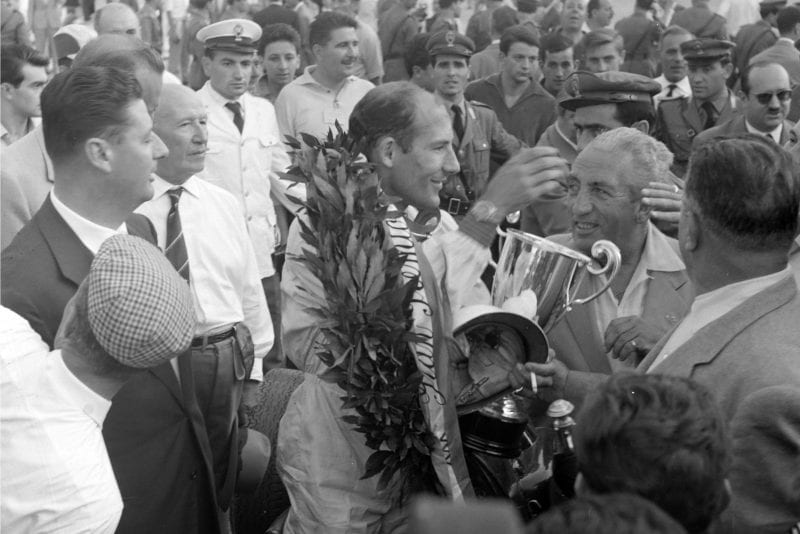
Stirling Moss after the race
Motorsport Images
Aston Martin had three of their six-cylinder Formula 1 cars, the third one being a spare for training for Salvadori and Shelby, while Lotus had taken all the mechanical components off the car that Graham Hill crashed at Lisbon, and built them into an earlier Formula 1 chassis that they had used at the beginning of the season, which he had driven so well At Zandvoort, and Ireland retained his same car.
Against this strong British entry were ranged five cars from the Scuderia Ferrari, all more or less identical and unchanged from previous races, with Brooks, Phil Hill, Gurney, Allison and Gendebien as drivers, while Centro-Sud entered their two Cooper-Maseratis for Colin Davis and Burgess, these two cars still having old type Cooper gearboxes now modified to the drip-feed oil system controlled by a cable, as used on the works cars at Zandvoort. To complete the entry the Swiss driver Volonteris entered his 250F Maserati for Cabianca to drive, and Scarlatti entered the recently completed Tec-Mec Maserati-engined Special, but it failed to materialise.
